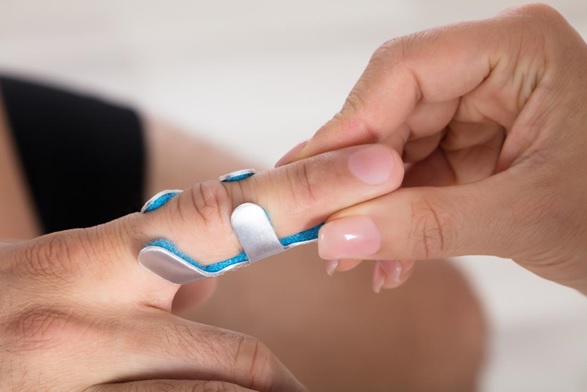Jammed finger vs. broken finger: What to know

Last reviewed Thu 22 March 2018
By Rachel Nall, RN, BSN, CCRN, Reviewed by Gregory Minnis, DPT
A jammed finger is a common injury that can cause pain, swelling, and difficulty moving the finger.
A jammed finger is most commonly caused by an injury to the joint in the middle of the finger, where it bends in half. This joint is called the proximal interphalangeal joint (PIP).
Small ligaments called the collateral ligaments support the PIP joint. A jammed finger may occur when then these ligaments are overstretched or strained.
This damage can happen when the hands absorb too much force, such as when someone catches a ball when playing sports.
A jammed finger can be uncomfortable, but it is not usually a serious injury. At-home and medical treatments can help the finger heal without complications.
Symptoms

A jammed finger is characterized by swelling and stiffness.
A jammed finger causes swelling, difficulty moving the finger, and pain. The duration of the swelling will depend upon how severe the injury is.
Other signs of a jammed finger include:
- pain, but usually not severe
- stiffness
- weakness, or difficulty holding onto an item
- redness and swelling
Causes

Jammed fingers are a common sports injury, especially in sports where the hand absorbs the impact of the ball, such as basketball, baseball, and volleyball.
A jammed finger occurs when the tip of a person’s finger presses forcefully against the hand. This action can cause the ligaments in a person’s finger to become overstretched or strained.
Other potential causes include:
- closing a drawer or door on the finger
- injuring the finger on the steering wheel during an automobile accident
- putting the hand down to break a fall
Any action that puts extra strain on the PIP joint can result in a jammed finger.
Jammed finger vs. broken finger

A broken finger is often more painful than a jammed finger, although both may be treated using a splint.
A broken finger will cause severe pain and swelling that lasts for hours or even days. While a jammed finger is painful, it is not usually severe.
A doctor can usually tell the difference between a jammed finger and a broken finger based on a visual examination.
A broken finger may have a bone either visibly sticking out of the skin or will be protruding toward the skin. A person may hear a cracking or popping noise with finger movement if they have a broken finger.
A doctor will also ask the person to try to move their finger. A jammed finger will usually have some range of motion, but if a person has a broken finger, they will hardly be able to move it.
If it is still not clear whether the finger is jammed or broken, a doctor may take an X-ray to confirm the diagnosis.
Treatment
Doctors commonly treat a jammed finger with a splint, which is a brace that keeps the finger straight and stable while the damaged ligaments heal.
Another option is known as buddy taping or wrapping, where the injured finger is taped securely to a non-injured finger for support. Buddy wrapping helps to stabilize the injured finger.
There is a useful at-home treatment for jammed fingers known as PRICE. It stands for:
- P is for protection. Wearing a splint or buddy wrap can help to make the finger less vulnerable to injury.
- R is for rest. Resting and avoiding using the hand as much as possible will protect the finger.
- I is for ice. Applying a cloth-covered ice pack to the injured finger can help reduce inflammation and redness. Keep the ice on the finger for 10–15 minutes at a time.
- C is for compression. Splinting or wrapping the finger can help reduce inflammation and promote healing. However, do not bind the finger so tightly that circulation is affected.
- E is for elevation. Resting the hand on a pillow where the elbow is lower than the hand can help reduce swelling and pain.
Taking over-the-counter pain relief medications, such as acetaminophen and ibuprofen, can also help reduce pain and inflammation.
When to see a doctor

A finger that has been injured and appears crooked should be assessed by a doctor.
If a person injures their finger and it appears crooked, they should not attempt to straighten it themselves. Instead, they should see their doctor to examine and treat the injury.
A person should seek immediate medical attention if the finger starts to feel numb and turns white or very pale. These are signs that there is not enough blood flowing to the area.
A person should see their doctor as quickly as possible when:
- the finger appears deformed or crooked
- they develop a fever following the injury
- the finger becomes significantly swollen
- the finger starts hurting more instead of less over time
- the person cannot fully straighten the finger
If a person’s symptoms continue to get worse instead of better, they should see their family doctor or a doctor that specializes in the skeletal system called an orthopedist. Some orthopedists offer walk-in clinics to assess sports-related injuries.
